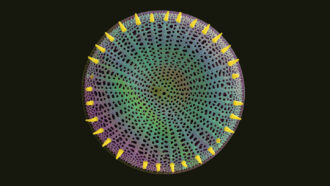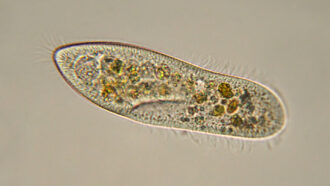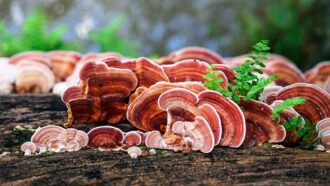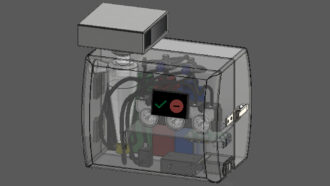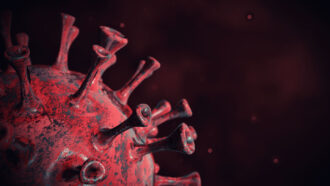The Bahamas’ African roots
Dust from the Sahara may have fed the islands’ growth
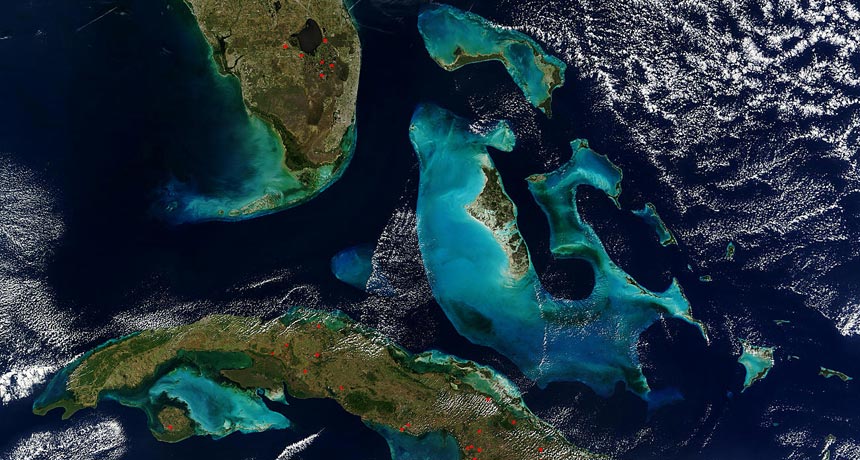
The big, light blue patch in the center of this image, captured in 2004 by NASA's Terra satellite, is the Great Bahama Bank. This shelf supports the Bahama islands. Scientists say the shelf was built by microbes fueled by dust blown across the ocean from the Sahara Desert.
Jacques Descloitres, MODIS Rapid Response Team, NASA/GSFC
Sun-loving tourists never question much about the Bahamas beyond what the weather will be like during their visits. But scientists have had plenty of questions about this island nation in the Caribbean. Chief among them is why the islands even exist. The conditions that allowed other Caribbean islands to form aren’t present in the region of the Bahamas. But some geoscientists now think they’ve discovered what makes the Bahamas possible: Africa’s Sahara Desert.
In a new study, these scientists present data that suggest the islands built up as a result of dust carried across the Atlantic Ocean from the Sahara. This immense desert covers most of the northern expanse of Africa.
Yet the Bahamas aren’t made from dust. Instead, the scientists suspect that Saharan dust fed ocean microbes called cyanobacteria. As these bacteria grow, they produce a material called calcium carbonate. This carbonate is the building block of the islands of the Bahamas. The geoscientists presented their idea June 30 in Geology.
For some 100 million years, that calcium carbonate accumulated on the seafloor. It initially formed an underwater shelf as large as Iceland. That shelf is called the Great Bahama Bank. The Bahamian islands are the uppermost peaks rising from that shelf.
“Without this dust, the Bahamas might never be there,” Peter Swart told Science News. “We’d just have a big open ocean and maybe a little underwater bump.” Swart is a geochemist at the University of Miami in Florida.
Carbonate structures such as the shelf usually form from the skeletons of creatures like coral and mollusks. But few of those ocean creatures live near the Bahamas. That set scientists looking for another explanation.
Visitors to the Bahamas have long observed whitings. These milky-white clouds in the water can stretch up to 100 kilometers (62 miles) long and wide. That’s an area about the size of New York City’s island borough of Manhattan. Whitings are made of calcium carbonate. More than 20 years ago, scientists found cyanobacteria within the whitings. Cyanobacteria also produce calcium carbonate. So scientists reasoned that the microbes could have made the shelf.
But the cyanobacteria would have needed nutrients in order to grow and produce the calcium carbonate. “The Great Bahama Bank sits in a nutrient-poor environment,” Swart says. Where the microbes were getting their nutrients was a mystery.
So Swart’s team collected samples from the seafloor along the shelf. They discovered that samples from areas with more whitings had an unusual abundance of one nutrient — iron. Cyanobacteria eat iron. And where levels of iron are high, they can make more calcium carbonate.
The scientists also found that Andros Island, the largest island in the Bahamas, had the most whitings. It also had the highest levels of iron. And it sat on the thickest part of the shelf.
Dust blown across the ocean from the Sahara Desert contains high levels of iron. Swart and his team suspect this dust gets caught on islands like Andros and runs off into the water. It also falls into the surrounding ocean. There, it fuels the cyanobacteria. The microbes then produce huge plumes of calcium carbonate that build the Bahamanian islands.
Other scientists say Swart’s idea makes sense. “It needs some testing, but it ties everything together neatly,” Lisa Robbins told Science News. Robbins is an oceanographer at the U.S. Geological Survey in St. Petersburg, Fla. She did not work on the new study. She says: “Anyone who has a biology background will say, ‘Oh yeah, this makes sense.’”
Power Words
bacterium (plural bacteria) A single-celled organism forming one of the three domains of life. These dwell nearly everywhere on Earth, from the bottom of the sea to inside animals.
calcium A chemical element which is common in minerals of the Earth’s crust, and is also found in bone mineral and teeth.
calcium carbonate The main chemical compound in limestone, a rock made from the tiny shells of ancient marine organisms. Its formula is CaCO3 (meaning it contains one calcium atom, one carbon atom and three oxygen atoms).
coral Marine animals that often produce a hard and stony exoskeleton and tend to live on the exoskeletons of dead corals, called reefs
cyanobacterium A type of bacterium that can convert carbon dioxide into other molecules, including oxygen.
geochemistry A science that deals with the chemical composition of and chemical changes in the solid material of Earth or of another celestial body (such as the moon or Mars).
microbe Short for microorganism. (see microorganism)
microorganism A living thing that is too small to see with the unaided eye, including bacteria, some fungi and many other organisms such as amoebas. Most consist of a single cell.
nutrients Vitamins, minerals, fats, carbohydrates and proteins needed by organisms to live, and which are extracted through the diet.
weather Conditions in the atmosphere at a localized place and a particular time. It is usually described in terms of particular features, such as air pressure, humidity, moisture, any precipitation (rain, snow or ice), temperature and wind speed. Weather constitutes the actual conditions that occur at any time and place. It’s different from climate, which is a description of the conditions that tend to occur in some general region during a particular month or season.
